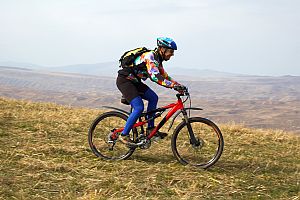Cycling is becoming more and more popular throughout the country, since it’s an inexpensive, environmentally-friendly way to get around and get great exercise at the same time. However, as with almost all good things, there are some drawbacks—and a significant drawback to cycling is back pain. Back pain is one of the most common complaints among cyclists. So what can be done about biking and back pain?
There are many sources of cycling-related back pain, among them muscle imbalances and weaknesses, poor hip mobility, tight psoas muscles and poor bike fit. Fortunately, all of these are controllable. Note that in many cases your pain will be a combination several factors, so although you might suspect one over another, you should investigate them all to discover the root cause of your pain.
Muscle Imbalances and Weaknesses
Cycling actually doesn’t provide much of a workout for the back itself or the core muscles in your torso. It also tends to work the quadriceps (front of the leg) more than the hamstrings or gluts (back of the leg and buttocks). The thousands of repetitions using some muscles to the exclusion of others lead to muscle imbalances and weaknesses. These can only be corrected away from the bicycle with exercises designed to counterbalance the time spent cycling and work on opposing sets of muscles. The solution is to follow a core exercise routine that helps strengthen the transversus abdominus and the gluteus maximus.
Hip Mobility
Hip mobility is an often overlooked but vital aspect of cycling. The hip transfers power from the core to the bicycle. If the hip joint is ‘tight’ and not moving freely, it interferes with power transfer and can cause back pain. The forward leaning position of cyclists will cause the hip flexors to tighten and shorten. For workers that spend long hours sitting, their hip flexors are already shortened and tightened to begin with. The solution is to do cycling drills at very high ROMs (repetitions per minute) along with hip flexor stretches.
Temporary Sensory Motor Amnesia
Have you ever carried a bag of groceries with your arm at a 90 degree angle and afterward felt like you couldn’t quite straighten your arm out? The phenomenon is called temporary sensory motor amnesia. If the activity you are performing is transient (such as carrying groceries) the effect will reverse itself on its own in a few minutes. However, if you are frequently repeating a position (such as crouched on your bike) your body can come to think of the new position as normal. At that point you have to actively retrain your brain and body to fully restore function. While cycling you are using the psoas muscle in a shortened position. When you get off the bike it can feel like it is difficult to stand up straight. What’s happening inside is that the psoas muscles aren’t releasing and they are overpowering the back muscles that are trying to stand straight. The solution is to do stretches for the psoas muscles using the Warrior I yoga pose daily and especially after every bike workout.
Poor Bike Fit
There is too much to say about fitting a bicycle properly for this small space. Suffice it to say that an improper positioned maintained for long periods of time is a recipe for back pain. If you add to that, physical exertion while in a poor position, you have a recipe for disaster.
Get the help of a professional when choosing a new bicycle. Take your time testing it. Don’t just try it out for thirty seconds in the shop—try to arrange a longer test ride on the bike before purchasing.
There are many lengths and angles that can be adjusted on a bicycle. A professional bike fitter will take into account several measurements such as the angle of your lower leg relative to the ground, the angles through which your hip joint cycles, the seat height and the distance between the seat and handles.

